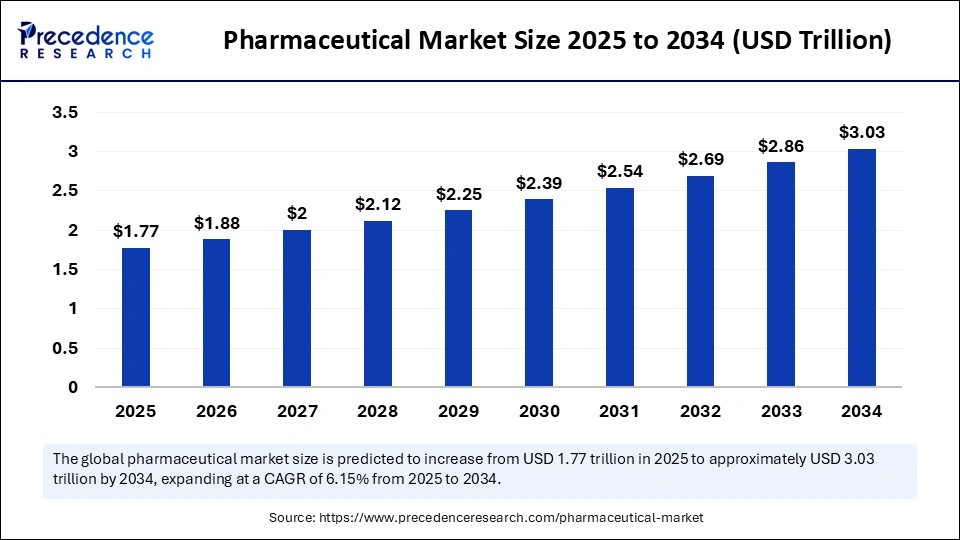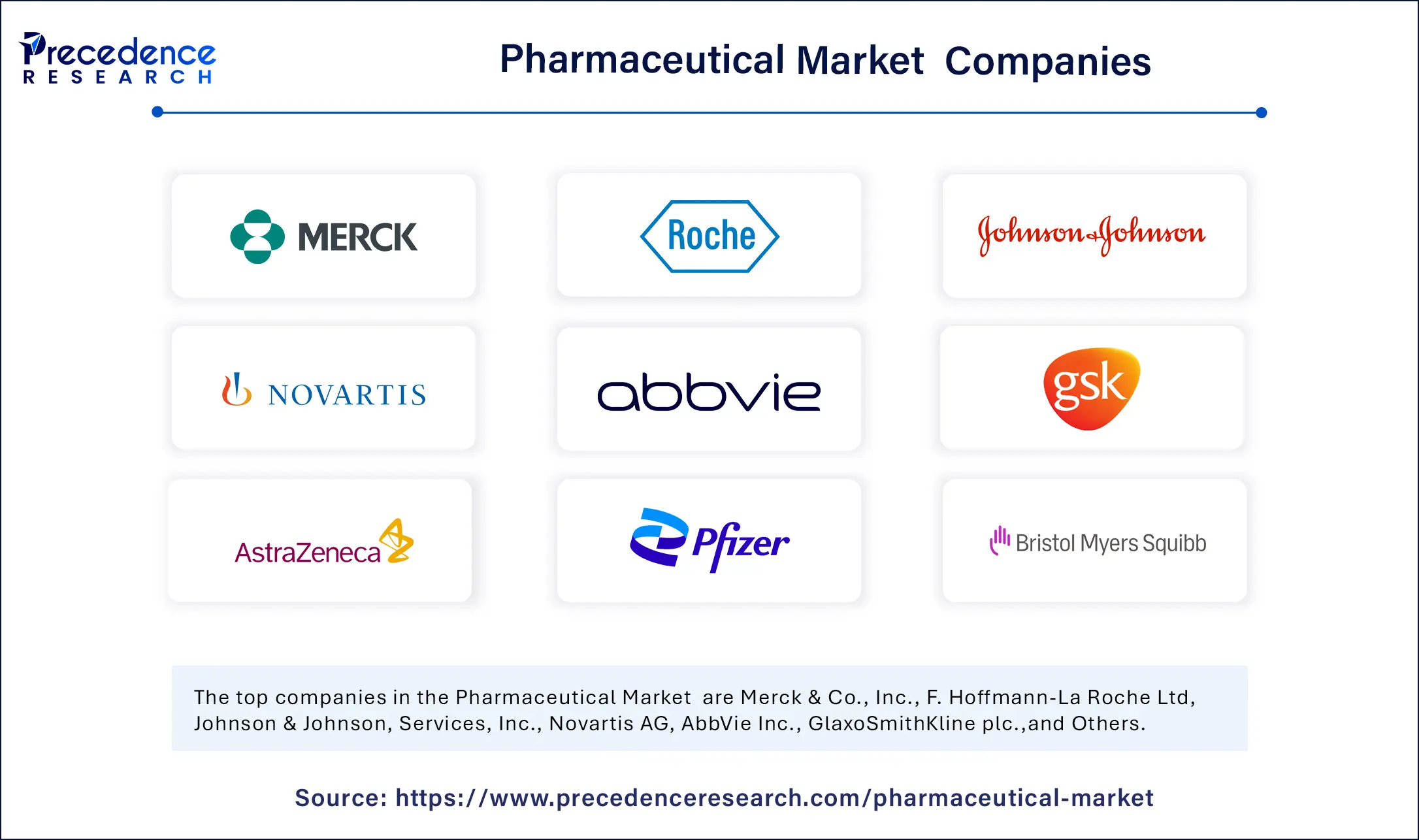
Pharmaceutical Market Key Takeaways
- North America dominated the global market with the largest revenue share of 42% in 2024.
- Asia Pacific is expected to register the fastest CAGR from 2025 to 2034.
- By type, the prescription segment held the major market share of 87% in 2024.
- By type, the over-the-counter (OTC) segment is anticipated to grow at the fastest CAGR in the coming years.
- By molecule type, the conventional drugs (small molecules) segment contributed the largest market share of 55% in 2024.
- By molecule type, the biologics and biosimilars (large molecules) segment is projected to expand at the highest CAGR between 2025 and 2034.
- By product, the branded segment captured the highest market share of 87% in 2024.
- By product, the generic segment is expected to grow at the fastest CAGR during the forecast period.
- By disease, the cancer segment generated the biggest revenue share of 19% in 2024.
- By disease, the obesity segment is forecast to grow at a significant CAGR between 2025 and 2034.
- By route of administration, the oral segment accounted for the largest market share of 58% in 2024.
- By route of administration, the parenteral segment is expected to expand at a notable CAGR during the forecast period.
- By age group, the adults segment captured the highest market share of 64% in 2024.
- By age group, the geriatric segment is anticipated to grow at a significant CAGR in the upcoming period.
- By distribution channel, the hospital pharmacies segment dominated the market with a major share of 54% in 2024.
- By distribution channel, the retail pharmacies segment is expected to grow at the fastest rate over the projection period.
Pharmaceutical Market Overview and Growth Outlook
The pharmaceutical market is a cornerstone of global healthcare, delivering innovative therapies to combat a wide range of diseases, from chronic conditions and rare disorders to acute infections. Fueled by breakthroughs in biologics, personalized medicine, and digital health, the industry continues to evolve rapidly. Growing life expectancy, rising prevalence of non-communicable diseases, and expanding access in emerging economies are fueling market expansion. As governments balance healthcare costs with patient needs, the pharmaceutical landscape is poised for strong, consistent growth.
Role of AI in the Pharmaceutical Market
Artificial Intelligence is revolutionizing every stage of pharmaceutical development and delivery. In drug discovery, AI systems analyze molecular structures and biological data to identify promising candidate compounds. During clinical trials, machine learning models improve patient selection, forecast outcomes, and refine trial protocols. AI also enhances pharmacovigilance and safety monitoring by detecting potential side effects in real time. Furthermore, AI streamlines manufacturing through process automation, predictive maintenance of equipment, and quality control. Patient-focused applications — such as personalized dosage systems and AI-driven telehealth platforms — are further enhancing treatment adherence and outcomes.
Pharmaceutical Market Growth Factors
Innovations in biologics and cell & gene therapies are key growth drivers, offering targeted treatment options across oncology, immunology, and rare diseases. Patent expiries in high-revenue small molecule drugs are encouraging the rise of biosimilars and generics, expanding access and cost-efficiency. Increasing global disease burden—driven by aging populations and lifestyle-related illnesses—is boosting demand for chronic care medications. Supportive regulations and reimbursement models are further enabling market entry and adoption of next-generation treatments, encouraging investment and development in emerging therapeutic areas.
Pharmaceutical Market Scope
The pharmaceutical market includes a broad portfolio: small molecule drugs, recombinant proteins, monoclonal antibodies, vaccines, biosimilars, and cell & gene therapies. It spans treatment categories such as oncology, cardiovascular, respiratory, neurology, metabolic disorders, infectious diseases, and immunotherapies. Sales channels range from hospitals and retail pharmacies to direct-to-patient delivery, hospital consolidation, and digital pharmacy services. The scope extends from R&D pipelines to regulatory pathways, manufacturing and quality assurance, and global distribution networks.
| Report Coverage | Details |
| Market Size by 2034 | USD 3.03 Trillion |
| Market Size in 2025 | USD 1.77 Trillion |
| Market Size in 2024 | USD 1.67 Trillion |
| Market Growth Rate from 2025 to 2034 | CAGR of 6.15% |
| Dominating Region | North America |
| Fastest Growing Region | Asia Pacific |
| Base Year | 2024 |
| Forecast Period | 2025 to 2034 |
| Segments Covered | Type, Molecule Type, Product, Disease, Route of Administration, Age Group, Distribution Channel, and Region |
| Regions Covered | North America, Europe, Asia-Pacific, Latin America, and Middle East & Africa |
Market Drivers
High unmet medical needs in chronic and rare diseases are pushing R&D investment into new drug modalities. Innovations in biotechnology—such as CRISPR, mRNA, and antibody-drug conjugates—are expanding therapeutic possibilities. Suppliers are leveraging global clinical trial networks and emerging market access to accelerate approvals and scale. Additionally, health policy reforms and drug pricing negotiations are encouraging generic and biosimilar competition, allowing pharmaceutical growth to balance innovation with wider availability.
Market Opportunities
Significant opportunities lie in personalized and gene-based treatments, especially in oncology, rare genetic disorders, and regenerative medicine. Growth in digital therapeutics, companion diagnostics, and patient-monitoring tools opens avenues for integrated pharma solutions. Emerging markets offer access expansion through localized manufacturing and decentralized care models. Breakthroughs in drug delivery—like conjugated antibodies, nanoparticle carriers, and inhalables—are also creating chances for competitive differentiation.
Market Challenges
High R&D costs, long development timelines, and complex regulatory approval processes remain major barriers. Patent cliffs and pricing pressure from governments limit profit margins on branded drugs. Data integrity and supply chain security are under scrutiny, as are growing concerns over counterfeit medicines. Healthcare disparities and uneven distribution infrastructure continue to pose challenges in emerging economies. Ethical concerns related to gene editing, data privacy, and equitable access further complicate industry innovation.
Pharmaceutical Market Regional Outlook
North America remains the largest pharmaceutical market, driven by high healthcare spending, market-leading innovation hubs, and extensive clinical trial ecosystems. Europe is a close second, with robust generics and biologics industries and regulatory alignment through centralized EMA pathways. Asia-Pacific is the fastest-growing region, fueled by expanding middle-class populations, domestic manufacturing, and rising investment in drug development. Latin America and Middle East/Africa are emerging markets, where regulatory reform and improved healthcare access are unlocking new opportunities.
Future Outlook and Trends
The future of the pharmaceutical market revolves around precision medicine, next-gen biologics, and digital health integration. Expect wider commercialization of mRNA and gene therapies, accelerating breakthroughs in previously untreatable conditions. AI and real-world data platforms will drive decentralized trials and adaptive regulatory models, making drug pathways more efficient. Collaborations between pharma, tech, and healthcare systems will evolve new care delivery models, such as pharma-as-a-service and patient-centered ecosystems. Sustainability initiatives in supply chains and green chemistry will become central to corporate strategies.
Pharmaceutical Market Companies

- Merck & Co., Inc
- F. Hoffmann-La Roche Ltd
- Johnson & Johnson Services, Inc.
- Novartis AG
- AbbVie Inc.
- GlaxoSmithKline plc.
- AstraZeneca
- Pfizer Inc.
- Bristol-Myers Squibb Company
- Sanofi
- Takeda Pharmaceutical Co., Ltd.
Segment Covered in the Report
By Type
- Prescription
- OTC
By Molecule Type
- Biologics & Biosimilars (Large Molecules)
- Monoclonal Antibodies
- Vaccines
- Cell & Gene Therapy
- Others
- Conventional Drugs (Small Molecules)
By Product
- Branded
- Generics
By Disease
- Cardiovascular diseases
- Cancer
- Diabetes
- Infectious diseases
- Neurological disorders
- Respiratory diseases
- Autoimmune diseases
- Mental health disorders
- Gastrointestinal disorders
- Women’s health diseases
- Genetic and rare genetic diseases
- Dermatological conditions
- Obesity
- Renal diseases
- Liver conditions
- Hematological disorders
- Eye conditions
- Infertility conditions
- Endocrine disorders
- Allergies
- Others
By Route of Administration
- Oral
- Tablets
- Capsules
- Suspensions
- Other
- Topical
- Parenteral
- Intravenous
- Intramuscular
- Inhalations
- Other
By Age Group
- Children & Adolescents
- Adults
- Geriatric
By Distribution Channel
- Hospital Pharmacy
- Retail Pharmacy
- Others
By Region
- North America
- Europe
- Asia-Pacific
- Latin America
- Middle East & Africa
Also Read: Anti-D Immunoglobulin Market
Get this report to explore global market size, share, CAGR, and trends, featuring detailed segmental analysis and an insightful competitive landscape overview @ https://www.precedenceresearch.com/sample/6227
You can place an order or ask any questions, please feel free to contact at sales@precedenceresearch.com|+1 804 441 9344
- Arteriovenous Implants Market Enhance dialysis outcomes with advanced grafts, endovascular access, and AI-assisted precision - September 16, 2025
- Smart Retinal Implants Market Restore vision with wireless bioelectronic prosthetics and AI-powered retinal technologies - September 16, 2025
- Myopia Treatment Devices Market Size to Reach USD 38.51 Billion by 2034, Growing at a CAGR of 7.86% - September 1, 2025
